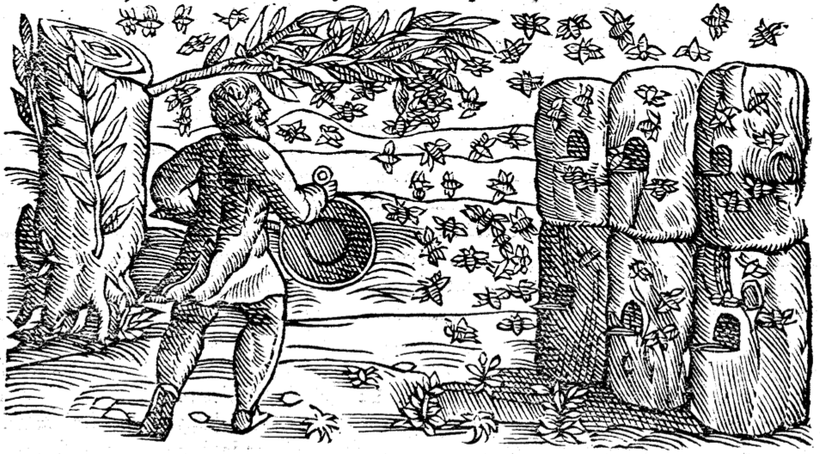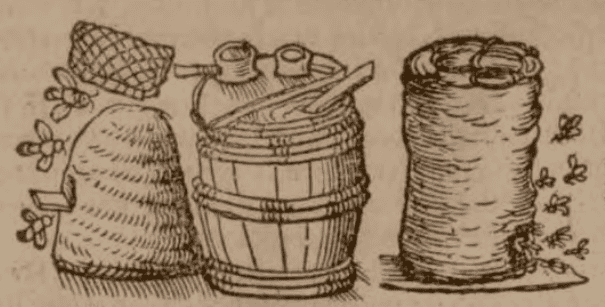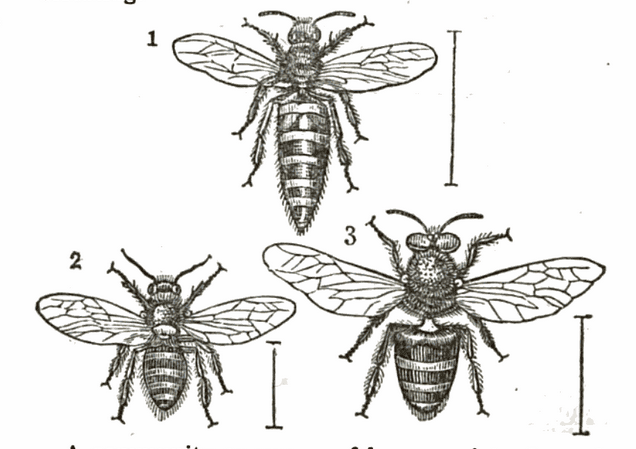Bees, Apis |

|
 Dioscorides Materia Medica, Mathias, 1563
Dioscorides Materia Medica, Mathias, 1563 Lustgarten der Gesundtheit, Ryff, 1546
Lustgarten der Gesundtheit, Ryff, 1546 1. Queen Bee, 2. Worker Bee, 3. Male Bee
1. Queen Bee, 2. Worker Bee, 3. Male BeeThe Natural History of Insects, Rennie, 1838
Botanical name:
Apis spp.
A. mellifera; A. indicus, A. sinensis (in China)
Parts used:
Whole dried Bees; usually toasted or ashed for use
Temperature & Taste:
Warm, dry. Sweet. Some said they are Warm and Moist
Uses:
1. Warms the Kidneys, Promotes Urine, Clears Damp:
-Edema, urinary Obstructions, Strangury, Cystitis
-Urinary Stones
-‘The agent is prescribed in Dropsy which appears suddenly’, as well as ‘sudden suppression of Urine’ (Ellingwood).
-‘Apis is one of the most certain diuretics in the materia medica’, having been used in such conditions as chronic Nephritis, Ascites, Anasarca and Hydrothorax (King’s).
-“Inflammation of the peritoneum, ovary, kidney, bladder, prostate gland with enlargement” (The medical genius – a guide to the cure, Jones, 1887)
2. Clears Wind, Cold and Damp, Eases Pain:
-rheumatism (internally and topically).
-various pains and neuralgias including Lumbar Pain, Sciatica, and Trigeminal Neuralgia.
-distilled water has been used for Apoplexy, Paralysis, Childhood Convulsions
-Sometimes a Bee is made to bite the painful area in arthritis etc.
-In Russia, it is also used as an effective remedy for Hypertension.
3. Moves the Blood, Promotes Menstruation (TCM, West):
-menstrual irregularity and dysmenorrhea accompanied with urinary difficulty
-Menorrhagia, Amenorrhea
-Ovarian pain and congestion for which it is said they give ‘prompt relief’ (King’s).
-Leukorrhea and genital puffiness with irritation.
-‘If they be given to any barren creature, they shall conceive in a short time after’ (The English Unparalleled Physician, Border, 1651).
4. Clears Toxic Swellings (TCM, West):
-Fibroid Tumors, Scrofula, Cancer and other toxic swellings; it was said to ‘prevent the wasting of the preternatural humors causing these diseases’.
-Ovarian Tumors were reputedly cured in 5 or 6 weeks by drinking a tea of 12 Bees every day. (Fernie, Animal Simples, 1899)
-Effective against Rheumatic Fever, Hives, Rubeola and Scarlatina and has been used for Lupus and Malaria
-vesicular Erysipelas, and all subcutaneous inflammations with itching and burning
-inflammation of the tongue, mouth and throat; Eclectic physicians used it for edema of the throat accompanying Diphtheria and Scarlet Fever, and for effusion from Pleuritis
5. Benefits Sight:
-poor, failing or dim eyesight;
-also deafness. (Salmon)
6. Externally:
-Applied topically to promote hair growth, including Alopecia (often the ashes were used for this purpose).
-Bees have been made to sting locals areas for acute pain, neuralgia, rheumatic and arthritic complaints. In China, Bees are sometimes made to sting specific acupoints for these purposes.
Dose:
To promote Urine, 10–20 grains of the powder, or one dried and powdered Bee, taken twice daily often promotes copious water.
2–12 Bees in powder are taken in beer or wine for Stones and Edema (1–2 Bees for mild cases, 10–12 for severe cases.
In Infusion: a teacupful of boiling water is poured over 12 Bees, this taken in 3 doses over the course of the day for Tumors.
Main Combinations:
1. To promote Urine:
i. Bee with Parsley root
ii. 5 bees powdered and taken in wine
2. To strongly promote Urine, and for Fibroid Tumors, combine Bee with Pill Millipedes
3. Gravel and Stones, Bee with Egg shell powder and Thyme
4. “Ovarian Tumor.—(Size of a child’s head) cured in 5 weeks, by putting 12 live honey bees in a teacupful of scalding water, and having the patient take a tablespoonful of this tea, 3 times a day”. (The medical genius – a guide to the cure, Jones, 1887)
5. Toxic swellings and Fibroids, combine Bee with Winter Cherry
6. Infantile Convulsions, Bee with Peony root
7. To promote Hair growth:
i. take a handful of Bees, powder and mix with Olive oil to be applied topically.
ii. Bee ashes, Southernwood ashes in Almond oil
iii. Bee ashes were combined with mouse dung in oil of Roses
iv. Bees, Cantharides (equal parts), boil with Oil of Camomile and apply (Border, 1651)
Cautions:
1. Bee powder (and especially Bee venom) should be used cautiously.
2. Very drying, so not suitable in Yin deficiency.
3. Avoid in Pregnancy.
4. Bees and Bee venom are generally not used in Diabetes, Tuberculosis, congenital Heart disease and Venereal diseases.
5. Side effects may include fever, headache, rash, tinnitus, diarrhea etc. In these cases, use should be discontinued
6. Bee ashes were said to cause hematuria if an overdose was taken. It should not be used in heat or inflammation of the Urinary tract.
Main Preparations used:
Bee ashes, Distilled Wate, Spirit of Bees, Salt of Bees
Spirit of Bees
“The Spirit extracted from Bees is ufeful against Syncopes, Faintings, hysteric Fits, Vapours, malignant Feyers, Stone, Gravel, and all Obstructions of Urine”. (Medicinalis Hibernica, K’eogh, 1739)
Dose from 20 Drops to 30, in any proper Vehicle
Salt of Bees
“The Salt extracted from calcined Bees, is a very powerful Diuretic, it is also an excellent Medicine to cure the King’s-evil, cancerous Tumours, and the Scurvy, being a great Sweetner of the Blood”.
Dose 10 Grains in any proper Vehicle. (Medicinalis Hibernica, K’eogh, 1739)
-
Extra Info
-
Case History
-
Research
GENERAL / REVIEW:
–Bee and Wasp Venoms: The biochemistry and pharmacology of their peptides and enzymes are reviewed.
ANTIBACTERIAL
–Antibacterial activity of bee venom collected from Apis mellifera carniolan pure and hybrid races by two collection methods
–Antimicrobial activity of apitoxin, melittin and phospholipase A2 of honey bee (Apis mellifera) venom against oral pathogens
–Antibacterial activity of Italian (Apis mellifera) bees venom
ANTI-INFLAMMATORY
–Inhibition of COX-2 activity and proinflammatory cytokines (TNF-α and IL-1β) production by water-soluble sub-fractionated parts from bee (Apis mellifera) venom
–Anti-inflammatory property of 401, a peptide from the venom of the bee(Apis mellifica L).
–Adolapin-a newly isolated analgetic and anti-inflammatory polypeptide from bee Venom
ANALGESIC:
–Adolapin-a newly isolated analgetic and anti-inflammatory polypeptide from bee Venom
ARTHRITIS
–Effects of bee venom in experimental arthritis
–Efficacy and Safety of Honey Bee Venom (Apis mellifera) Dermal Injections to Treat Osteoarthritis Knee Pain and Physical Disability: A Randomized Controlled Trial
DIABETES
–Therapeutic Potential of Peptides Derived from Animal Venoms: Current Views and Emerging Drugs for Diabetes
REDUCES TESTOSTERONE AND SPERM COUNT
–Low semen quality and adverse histological changes in testes of adult male mice treated with bee venom (Apis mellifera)
RADIOPROTECTIVE
–Radioprotective Effects of Honeybee Venom (Apis mellifera) Against 915-MHz Microwave Radiation–Induced DNA Damage in Wistar Rat Lymphocytes
ANTI-CANCER
–Cytotoxic effect of bee (A. mellifera) venom on cancer cell lines
BREAST
–Inhibition of mammary carcinoma cell proliferation in vitro and tumor growth in vivo by bee venom
–Honeybee venom and melittin suppress growth factor receptor activation in HER2-enriched and triple-negative breast cancer
LUNG
–Bee Venom Induces Apoptosis and Inhibits Expression of Cyclooxygenase-2 mRNA in Human Lung Cancer Cell Line NCI-H1299
–Bee Venom Triggers Autophagy-Induced Apoptosis in Human Lung Cancer Cells via the mTOR Signaling Pathway
